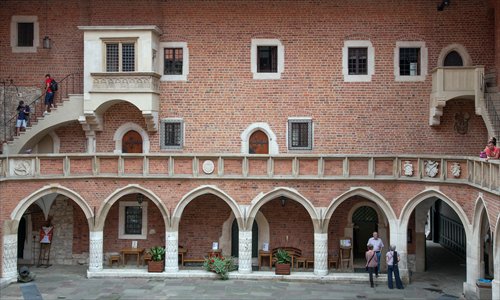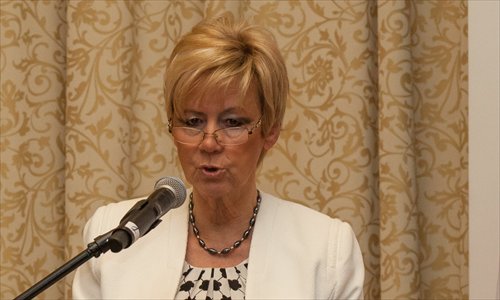Poland, China grow closer by degrees
Warsaw seeks foreign students and diploma deal with Beijing

Jagiellonian University in Krakow. Photo: IC
Since the establishment of Jagiellonian University in Krakow in 1364, Poland's higher education has traveled a long road. Against the backdrop of internationalization and a declining birthrate, the country's higher education system faces new opportunities and challenges, similar to those facing China.
During an exclusive interview with the Global Times on September 27, Vice Minister of Science and Higher Education Daria Lipinska-Nałecz said that further reform is needed to make Poland more competitive internationally. "Knowledge and science are reforming our lives. Why shouldn't we reform the sciences, and the institutions of science, at the same time?" she said.
On September 21 and 22, Chinese officials joined ministers of higher education and other officials from 16 central and eastern European countries in an education summit in Warsaw, to strengthen cooperation and improve higher education. Leaders of universities in Poland and China also attended.
Modernizing education
Poland has undergone two major recent higher education reforms, according to Lipinska-Nałecz.
In 2011, the standards and requirements made by the ministry for curriculum were cancelled, and higher education institutions were given the chance to create their own education programs, in order to better respond to the needs of the region where the school operates.
In 2014, the higher education system opened up for older people and people with work experience, by broadening the type of experiences and achievements that could lead to admission.
However, Lipinska-Nałecz pointed out that the reforms are not enough. "There are still too many bureaucratic limits," she said.
Since the Communist rule ended in 1989, a large number of private schools have opened throughout Poland. However, due to a dropping birthrate, the 96 public and 319 private universities in Poland are now facing a severe decline in enrollment.
The solution is fewer universities. "We have to merge some universities, to make them more powerful and efficient," she said. Since 2012, 21 mergers have happened between Polish private universities.
Unemployment among university graduates has become one of the most discussed problems among Poles nowadays.
Lipinska-Nałecz said that the solution lies in reforms that strengthen synergy between higher education and regional economic development.
"[Graduates] should be able to find good jobs in the places they were born. The strategies [of higher education and regional development] should match each other."
Despite criticism, she pointed out pilot data that shows having a degree helps with employment, since unemployment among graduates from a university is 11 percent, compared to 15 percent among those who graduated from vocational schools.

Daria Lipinska-Nalecz, vice minister of science and higher education of Poland. Photo: Courtesy of the Ministry of Science and Higher Education of Poland
To test or not to test
While China and Poland share problems, including a demographically caused drop in enrollment, there are a lot of differences.
Lipinska-Nałecz explained that Poland tries its best to boost creativity and avoid emphasizing tests. There's no national college entrance exam in Poland, and the enrollment is determined by the overall performance throughout high school and the final test of high school.
"Universities are not to pass knowledge, but to allow people to understand some area of knowledge, organize this knowledge, and know how to find good sources of knowledge."
In Chinese society, although young students test well internationally, people blame the test-oriented system for depriving students of creativity and depriving the nation of scientists who are innovative enough to win important prizes, such as the Nobel prize.
On the other hand, a recent BBC documentary showing Chinese teachers successfully helping British students improve their test scores triggered discussion around the pros and cons of Western education versus Chinese education.
Lipinska-Nałecz speaks highly of the Chinese style of teaching, which is criticized by many educators.
She pointed out that students being willing to spend so much effort in reading, memorizing and researching at the library boosts the quality of China's higher education.
Mutual learning
At the summit, participants came to a mutual understanding that, on top of improving the quality of education, attracting students and researchers from other regions is the solution to fight national demographic slowdowns.
Poland had 46,000 foreign students in the academic year of 2014 and 2015. Compared to traditional popular destinations for overseas education such as the US and UK, the education sector in central and eastern European countries need to find where their advantages lie.
To draw students, Poland offers classes using the English language, as well as competitive costs of studying and living. Poland also attracts international students with the implementation of the Bologna Process, a scheme which allows foreigners studying in Poland to continue their education elsewhere in the European Union.
"China's education should focus on diversity," Chinese Vice Minister of Education Hao Ping told the Global Times. "China has become the world's second-largest economy, and people should have a world-level vision."
"Higher education in central and eastern European countries is strong with a long history, while China is comparatively weak. With a lot of newly established schools [in China], we need to learn from them how to strengthen education and research in core subjects," Hao said.
"What we need now is to push for agreement between China and Poland on mutual recognition of academic degrees," Lipinska-Nałecz said.